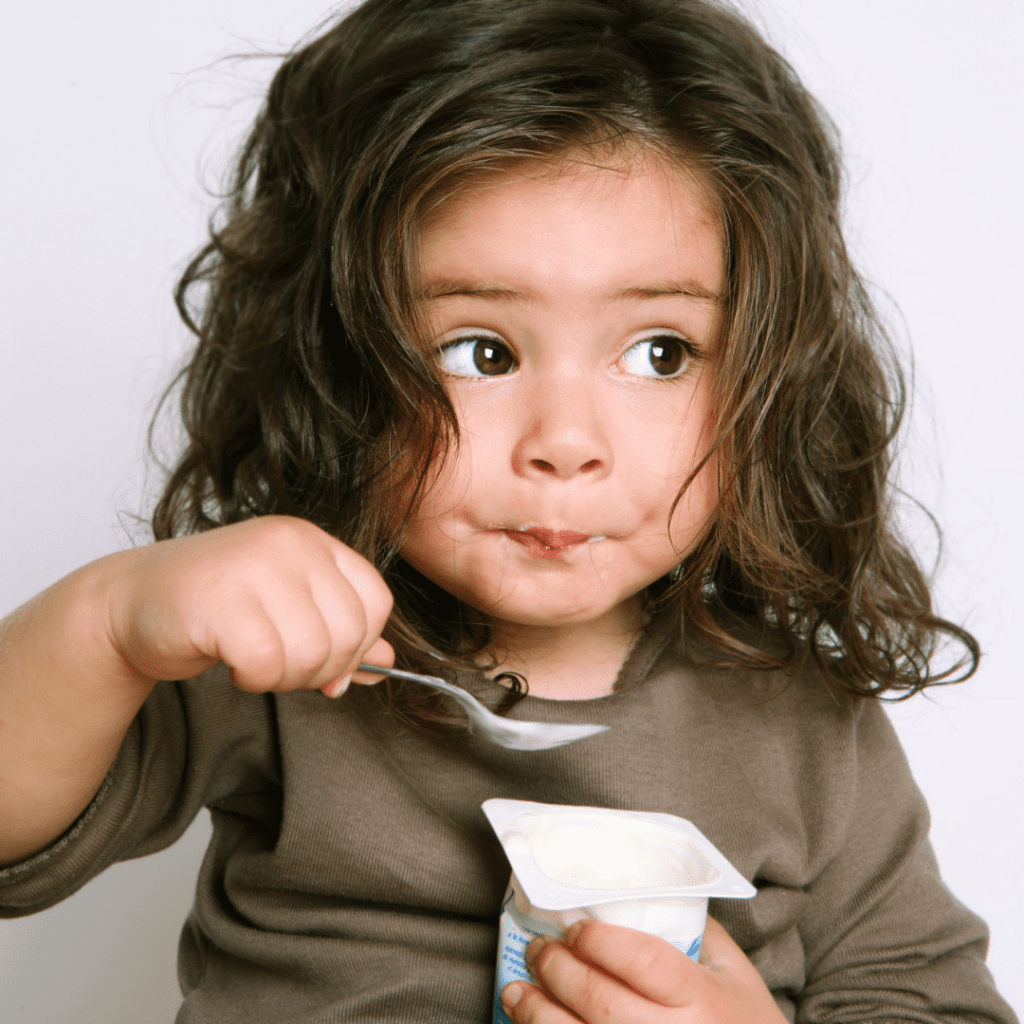Bread is just one of those foods – it’s delicious, comforting, and goes well with just about anything. So naturally, some of the most frequently asked questions we get from parents are about whether or not bread is ok for babies!
Spoiler alert – there are tons of things about bread that make it a great choice for babies! Plus, it can be an easy way to include some important nutrients in their diet too.
But it can be confusing to know when you can introduce bread, how to serve bread safely, and what the best brand of bread for babies is. There’s definitely no shortage in the variety of brands and different types of breads in the supermarket.
So, let’s cut to the chase and we’ll spell out everything you need to know about bread for your baby!
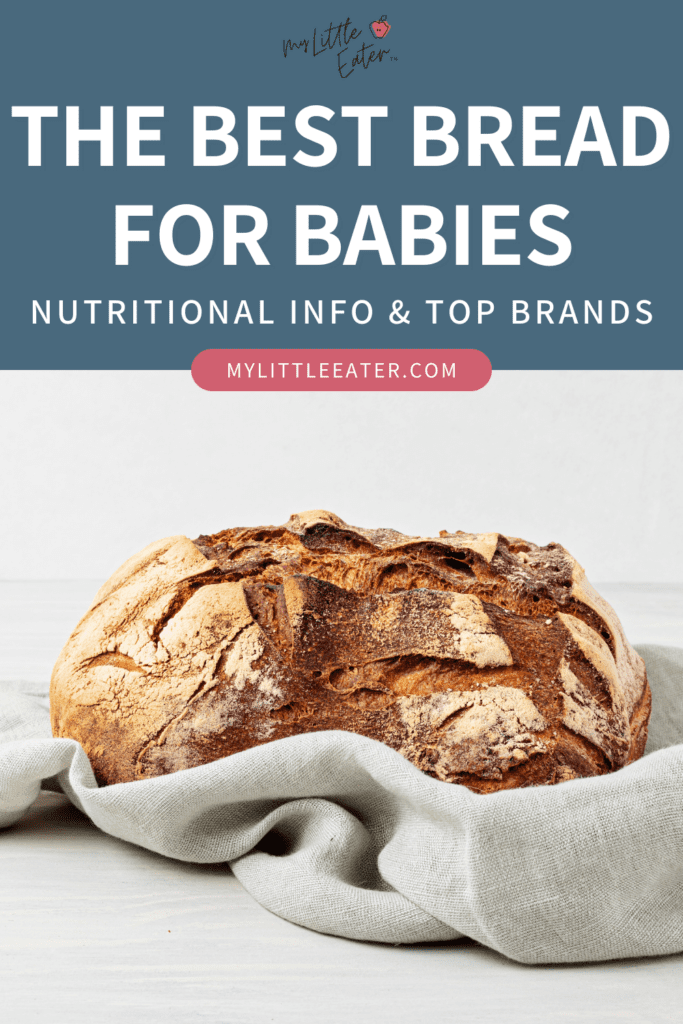
If you’re feeling stressed about starting solids and you’re not sure where to begin, join our FREE live workshop – How to start solids: A realistic first week of feeding your baby. This workshop is for parents ready to feel confident and prepared to start solids—without all the guesswork.
Learn exactly what to feed, when to feed it, and how to do it—step-by-step—with expert guidance from pediatric dietitian, Edwena Kennedy. Plus, get a free 5 day meal plan just for attending!
Table of Contents
If you prefer to listen while you multitask – download our podcast episode below to hear all the details!
When can you introduce bread to babies?
Babies can eat bread around 6 months of age, or as soon as they’ve started eating solids. There’s no reason to hold back on it as long as it’s introduced properly!
Lightly toasted bread is a great option for a first food, and can work really well if you’re diving right into baby led weaning.

Since bread contains wheat, it’s considered one of the highly allergenic foods. Introducing highly allergenic foods early is recommended, and it’s important to watch for any symptoms that may indicate an allergic reaction.
It’s also important to make sure you aren’t introducing it alongside another top allergen, like peanut butter, hummus, egg, etc. Only one allergen can be introduced at a time until you’ve ruled them out.
Learn more about introducing allergenic foods.
Best types of bread for baby
With an abundance of bread options in the grocery store, we know it can feel daunting to choose the best bread for baby. It’s important to know that no bread is considered unsafe when it comes to the main flour type.
All bread types like white, whole wheat, pumpernickel, sourdough, and rye can be varied in their diet to expose them to different flavors and increase their chances of becoming an adventurous eater in the long run!
Let’s get into some of our personal favorites though!
Sourdough bread

This is an all-time favorite because it isn’t as processed as other breads, which makes it easier to digest. Another bonus is that it lacks all the added sweeteners and preservatives that other breads can have.
Even though making your own has become extremely popular in recent years, it’s ok if you don’t want to! Store-bought is great to offer your baby as well.
Sprouted grain bread
Opting for a sprouted whole grain bread is the best choice nutritionally. These have limited preservatives like sugar and sodium, and they’re a better source of B vitamins (although breads that have processed flour must be fortified with these in Canada and the US), magnesium, fiber, and protein.
Breads that have been processed, like most of the commercial breads available today, have the outer shell of the grain removed which unfortunately removes a lot of the nutritional benefits.
Unlike processed wheat flours, sprouted grain flours are sprouted before they’re ground down. This makes all the nutrients more readily available and easier to digest so your baby can absorb them more!

Breads that are advertised as sprouted grain are usually a safe bet because they’re notorious for having low to no sodium, or added sweeteners. We’ll share some of our top brand picks below!
Whole wheat bread
This can be another great option, although there isn’t a need to focus on whole grains as much for babies compared to adults. Fiber is always great but sometimes too much of it can cause babies to fill up fast, leaving little room for other foods.
If you want to include a type of bread that has a higher fiber content, we recommend alternating throughout the week with a lower fiber option. This can help prevent any tummy upset or bloating that may happen from eating too much fiber.
How to choose the best bread for baby
The options above aren’t the only options that are good for babies! Now we’re going to teach you what to look for on the nutrition label when shopping for bread so you can pick one that works best for your family.
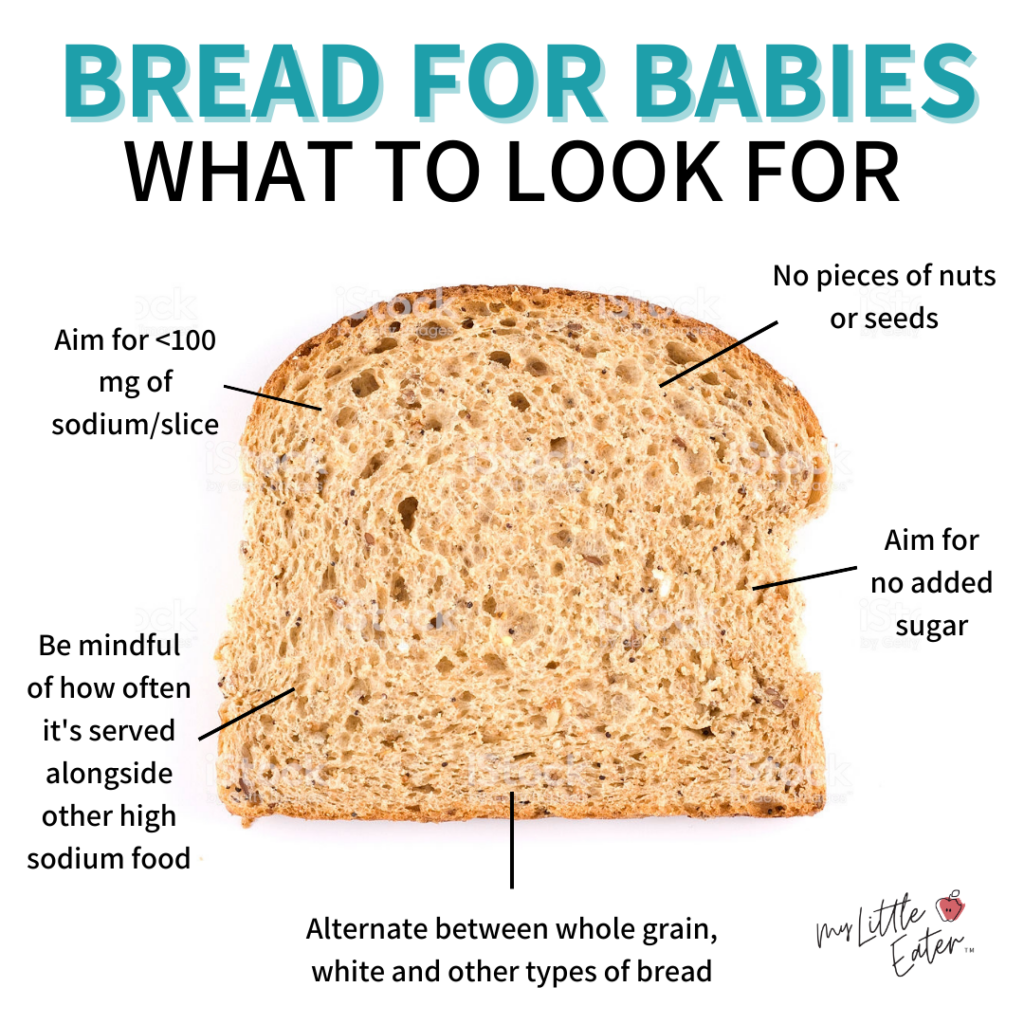
Limited or no sodium content
The sodium content is really important because when we look at the recommendations for sodium in a baby’s diet, it’s only 400mg per day up to 12 months of age. Approximately 200mg of that comes from breast milk or formula.
That only leaves 200mg, roughly, for all the solid foods in your baby’s diet. Believe it or not, a lot of bread provides that (and sometimes more) in just one slice!
When you’re looking at different breads, try to find a variety that has under 100mg per serving, or less, if at all possible.
Limited or no added sugars & sweeteners

Added sugars and artificial sweeteners are something you want to avoid when picking your baby’s bread. This might be more difficult than you think!
Most breads contain yeast to help them rise and become full once cooked. Yeast requires a “food source” to be able to achieve this and typically it’s sugar!
Healthier options will often only use the amount of sugar needed for the yeast, and won’t use more for added sweetness. Therefore, we recommend aiming for 2 g of sugar or less per serving.
Avoid large seeds or nuts
Try to avoid any bread that has whole or large seeds, like pumpkin seeds or sunflower seeds, on the crust or mixed into the bread. These are a choking hazard for your baby. The same is true for any bread that has nuts baked into it or on the crust.
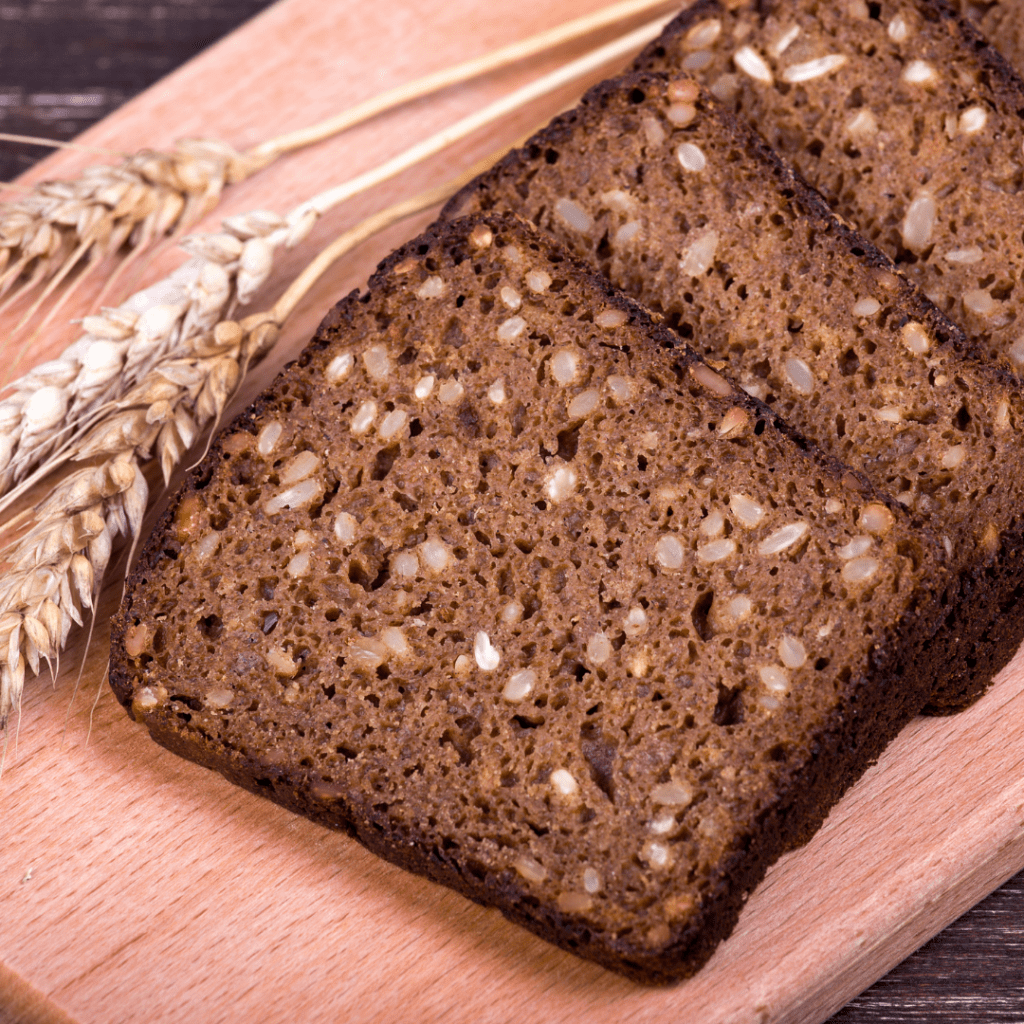
If the best option you can find has seeds or nuts on the crust, scrape the seeds off or remove the crust before serving.
Seeds like chia, hemp, or flax seeds are small and safe for babies, so there’s no need to worry about those.
Avoid honey as an ingredient
Honey is dangerous for babies under 12 months of age because it can have spores of bacteria that can cause infant botulism. Babies younger than 12 months are not able to move this toxin through the body and eliminate it before it causes issues like older children or adults with mature digestive systems would.
It’s crucial that you are really careful about checking the ingredient list for honey because it’s very often added to breads in order to add some sweetness. It also doesn’t matter whether the product is cooked after the honey is added or not, high cooking temperatures are not sufficient for removing the risk of the toxin.
Learn more about the risks of honey for babies and how to introduce it.
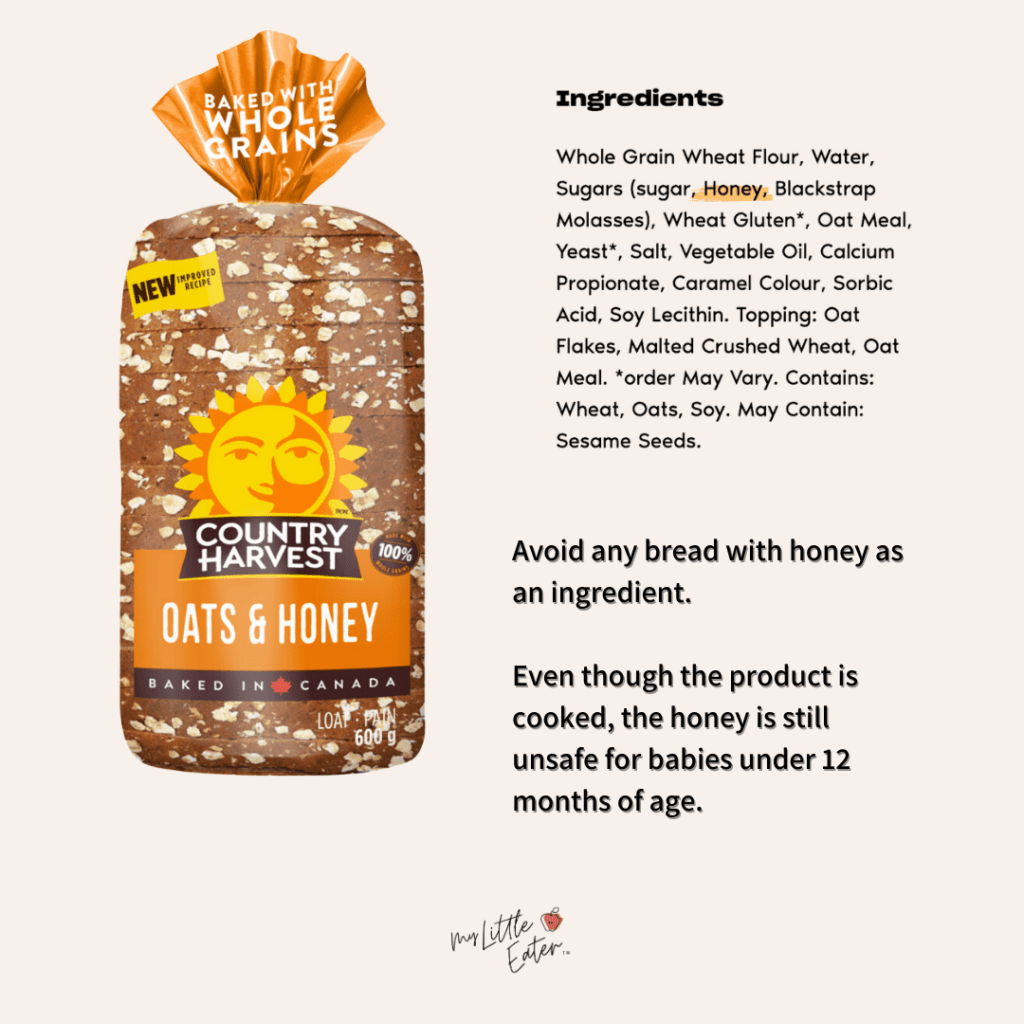
Top brand recommendations
Let’s take a look at our favorite bread brand options for your baby! Below we’ve compared some of the most popular brands that are nutritionally the best with one of the most well-known white bread options.
Unfortunately, our top recommendations run on the more expensive side since they’re organic and recognized as a healthier choice. But since your baby is just starting with solids, they likely won’t eat much anyway, which helps keep the cost down.
Top Tip
If you prefer a different type of bread from what you buy for your baby, keep their bread in the freezer!
Since your baby requires their bread to be toasted for safety (more on that later!), you can pull one slice out at a time to toast it. This will help keep it fresh for longer and you won’t have to worry about throwing away expensive bread that hasn’t been eaten.
Keep in mind that these options are just our suggestions but by no means are they the only options out there! No bread is 100% perfect, and it’s all about whatever works for your family in the long run!
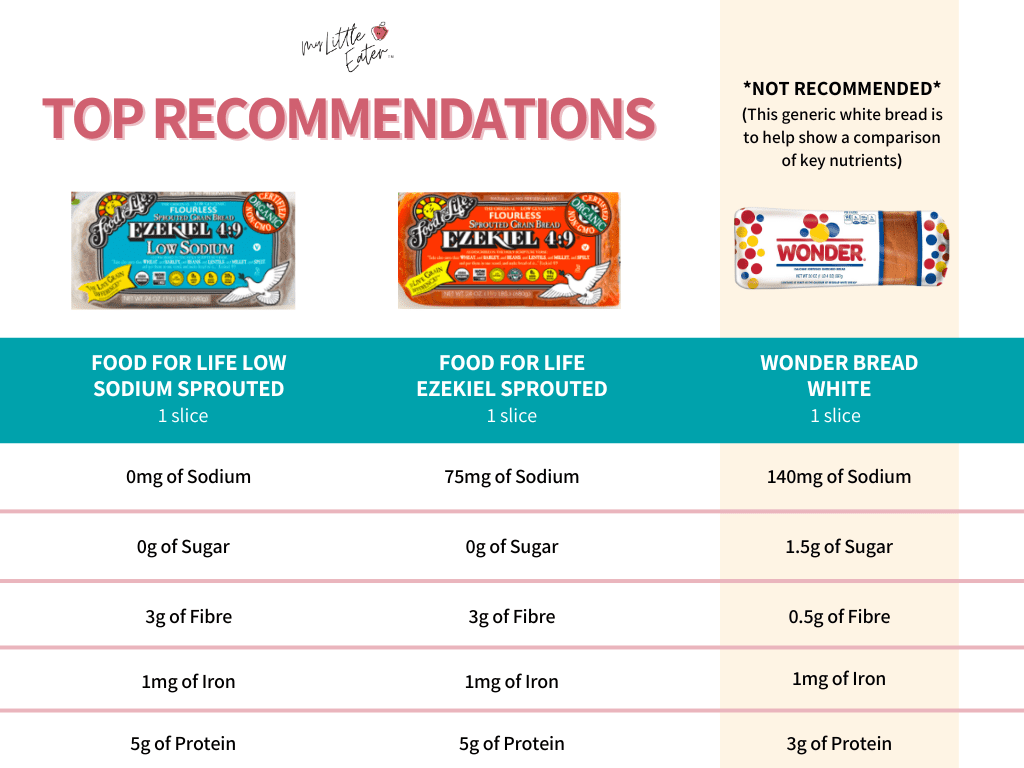
Food for Life Low Sodium Sprouted
If we had to choose just one, it would be this one!
With 0mg of sodium and 0g of sugar, it’s an easy yes from us. It also has 3g of fiber, 1mg of iron, and 5g of protein, which is comparable to the other top option. So the advantage here is definitely not having to worry about added sugar or sodium from bread.
Food for Life Ezekiel Sprouted
This is our second favorite option, and it only comes in second because it does have some sodium – but it still doesn’t have very much!
At only 75mg of sodium and 0g of sugar per slice, this is another great option for babies to help keep the amount of salt and sugar in their diet at a minimum.
Wonder White Bread
We added this in for comparison because it’s one of the more popular breads on the market. As you can see, it has higher levels of both sodium and sugar, plus a lot less fiber and protein per slice. For these reasons, it is not a bread we would recommend but we do understand that there are other factors to consider in your decision, such as cost.
It’s also important to note that it only contains one top allergen, whereas both Food for Life options contain 3 (wheat, soy, and sesame). Therefore, Food for Life bread cannot be used to introduce wheat if those other allergens have not been ruled out yet. But, something like Wonder Bread could be used if needed. There are other ways to introduce wheat as well, such as pasta, so it certainly isn’t necessary to offer this type of bread if you’d rather opt for something lower in sodium and sugar.
That said, the added benefit of Food for Life bread is that it continues to expose your baby to 3 top allergens every time it’s served. This makes it an easy way to keep exposures up to further reduce the risk of an allergy developing later on.
How to serve bread

As we mentioned earlier, lightly toasted bread is a great option for a first food – but not fresh, soft bread. That’s because fresh bread has a gummy, sticky texture that can glob up in your baby’s mouth making it a choking hazard until they’ve developed more advanced oral motor skills.
We recommend waiting until at least 18 months to introduce fresh bread. As always, every baby is different so they may be ready after this, do what feels best for your baby.
Read more for all the details on how to cut and serve bread according to our signature Texture Timeline™.
FAQs on the best bread for BLW
Can babies have tortillas?
Yes, they can but you will need to be careful about how you serve them.
We recommend serving corn tortillas over wheat varieties for babies 6-10 months of age because they aren’t as chewy and don’t as easily form globs in your baby’s mouth. Just as soft bread can be a choking risk when it balls up in your baby’s mouth, tortillas can do the same.
After 10 months of age, you can experiment with serving wheat flour tortillas. To do so, we recommend lightly toasting them first in a frying pan to reduce any gumminess, and add a little “crisp” that allows the tortilla to break apart in your baby’s mouth more easily.
Regardless of age, always coat your tortilla strips with a nutritious spread like mashed avocado or plain Greek yogurt for added moisture, just as you would for toast strips.
Can babies have English muffins or bagels?
English muffins are very similar in texture to various types of bread (gummy and overly soft when fresh) and therefore are better served lightly toasted (as you would for other white or whole grain breads).
Bagels are very thick and dense, which actually makes them safer when served untoasted. The reason for this is that untoasted bagels will crumble in your baby’s mouth more easily, and due to how thick and large even half a bagel is, it’s too hard for them to get big pieces in their mouth at once.
It also is harder for those pieces to form one big glob like it would with a strip of soft, thin bread. Baby can suck or munch on the end of a bagel and soften up the ends to get either loose crumbs in their mouth, or get smaller, more manageable pieces that they can chew.
You can also lightly toast a bagel for more resistance, which acts as more of a teether for babies (and less of something they can actually consume). As always, add a nutritious topping or spread to keep it moist and less of a choking risk.
Can babies eat naan or pita bread?
Yes! Naan bread is actually fairly easy to toast to the correct texture and is a great option for various spreads and toppings. Naan is slightly thicker than pita bread but is still safe for babies when lightly toasted.
Pita bread is also a safe option, especially with a moist topping and especially if it’s not super fresh, soft, and gummy. Offer one half of the pita at a time (vs a whole pita pocket) to reduce the risk of getting thick pieces of pita in the mouth at once.
Keep in mind – both naan and pita bread may not be easy for your baby to actually tear through and get calories from – however – there are still lots of benefits to using them as teethers, for gumming, and for building oral motor skills.
Can babies have other pastries?
With breads like muffins, dinner rolls, challah, brioche buns, etc. the main thing that you want to be concerned with is how “gummy” the texture is. Bread is not safe when it is soft enough to gum up and form a ball in your baby’s mouth, as mentioned above.
This is because the ball can be difficult for them to maneuver, can become stuck to the roof or sides of their mouth, and can easily block their airway. So if the bread or pastry is soft, and the options listed above typically are, they are better to offer after around 18 months of age when your baby has more practice chewing difficult textures.
Alternatively, you can offer your baby one or two very small, bite-sized pieces at a time, ensuring they chew and swallow what’s in their mouth before offering more.
So there you have it…the lowdown on bread for babies!
If you’re feeling overwhelmed about starting solids and you’re not sure where to begin, join our FREE workshop – How to start solids: A realistic first week of feeding your baby. This workshop is for parents ready to feel confident and prepared to start solids—without all the guesswork.
Learn exactly what to feed, when to feed it, and how to do it—step-by-step—with expert guidance from pediatric dietitian, Edwena Kennedy. Plus, get a FREE 5 day meal plan just for attending!



EDWENA KENNEDY, RD
Founder and lead Registered Pediatric Dietitian at My Little Eater Inc., creator of The Texture Timeline™, and mom of two picky-turned-adventurous eaters.

EDWENA KENNEDY, RD
Founder and lead Registered Pediatric Dietitian at My Little Eater Inc., creator of The Texture Timeline™, and mom of two picky-turned-adventurous eaters.

